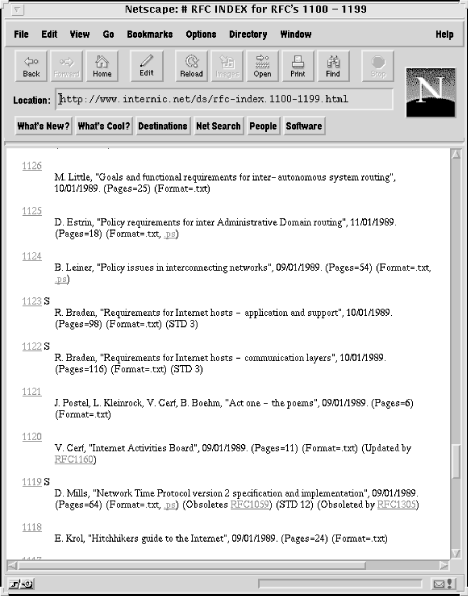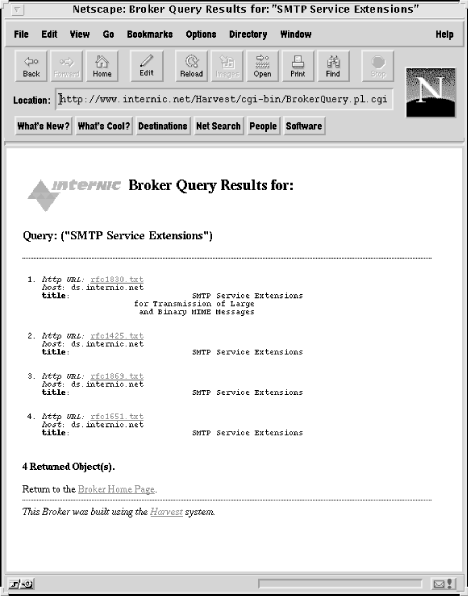 | Chapter 13 Internet Information Resources |  |
Throughout this book, we have referred to many RFCs. These are the Internet documents used for everything from general information to the definitions of the TCP/IP protocols standards. As a network administrator, there are several important RFCs that you'll want to read. In this section we describe how you can obtain them.
RFCs are available via the World Wide Web at http://www.internic.net. Follow the links from that home page through the directory services to the IETF RFC page. The page allows you to search the RFCs for keywords or to load the RFC index. The index is particularly useful if you know the number of the RFC you want. Figure 13.5 shows a network administrator scrolling through the index looking for RFC 1122.

In another example the network administrator does not know which RFCs contain the information she is looking for, but she knows what she wants. The administrator is trying to find out more about the SMTP service extensions that have been proposed for Extended SMTP. Figure 13.6 shows the four RFCs displayed as a result of her query.

The Web provides the most popular and best method for browsing through
RFCs. However, if you know what you want, anonymous FTP can be a
faster way to retrieve a specific document.
RFCs are stored at ds.internic.net in the rfc directory.
It stores the RFCs with filenames in the form rfcnnnn.txt or
rfcnnnn.ps, where nnnn is the RFC number and txt
or ps indicates whether the RFC is ASCII text or PostScript.
To retrieve RFC 1122, ftp to ds.internic.net and enter get
rfc/rfc1122.txt at the ftp> prompt. This is generally a very
quick way to get an RFC, if you know what you want.
To help you find out which RFC you do want, get the rfc-index.txt file. It is a complete index of all RFCs by RFC number, and it's available from ds.internic.net in the rfc directory. You'll only need to get a new RFC index occasionally. Most of the time, the RFC you're looking for has been in publication for some time and is already listed in the index. Retrieve the RFC index and store it on your system. Then search it for references to the RFCs you're interested in.
While anonymous FTP is the fastest way and the Web is the best way to get an RFC, they are not the only ways. You can also obtain RFCs through electronic mail. Electronic mail is available to many users who are denied direct access to Internet services because they are on a non-connected network or are sitting behind a restrictive firewall. Also, there are times when email provides sufficient service because you don't need the document quickly.
Retrieve RFCs through email by sending mail to
mailserv@ds.internic.net. Leave the Subject: line blank.
Request the RFC in the body of the email text, preceding the pathname
of the RFC with the keyword FILE. In this example, we request
RFC 1258.
%mail mailserv@ds.internic.netSubject:FILE /rfc/rfc1258.txt^D
The technique works very well. In the time it took to type these paragraphs, the requested RFC was already in my mailbox.